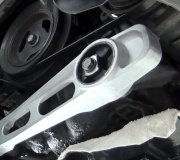Hi PhrozenBlur. Welcome to the forum. The engineers are doing a lot of really unnecessarily insane things to cost customers a lot of money, but unless there is something I'm not aware of, you are correct that the wires can be repaired. To add to the story, there is a huge selection of replacement connectors with a few inches of wire available at the parts stores to replace damaged connectors. The wires for those new connectors are spliced to the original harness without causing any problems.
Your mechanic may have had a bad experience after soldering a wiring repair in the past. A poor solder job can cause problems, especially in a high-current circuit. The coolant temperature sensor circuit is an extremely low-current circuit. The sensor already has a very high resistance. Adding a little more resistance from a less than perfect splice will not have an appreciable affect on the sensor's reading.
There is one thing to be aware of though. The only proper way to repair the wires is to solder them together, then slide heat-shrink tubing over the splices. No mechanical connectors are acceptable under the hood or where water can spray onto them. Those squeeze-type repair connectors are for people who are too lazy to do the job right. Outside of the passenger compartment, you are guaranteed they will allow corrosion to take place and you'll have intermittent problems in the future. Also, heat-shrink tubing with sealant inside is available for a water-tight joint.
As for the sensor's reading being "skewed", no two sensors will read exactly the same resistance at a given temperature and the engineers know that. So does the Engine Computer. He knows that after the engine has been off for a certain period of time and has cooled down, the coolant temperature sensor had better be reporting the same temperature as an ambient air temperature sensor or battery temperature sensor, or the sensing resistor inside a mass air flow sensor. The computer reconciles those readings and learns when one of those sensors has been replaced. Adding a little resistance to the circuit by repairing the wires will have a lot less affect on the readings than simply replacing the sensor.
Caradiodoc
Tuesday, June 29th, 2010 AT 12:01 AM


